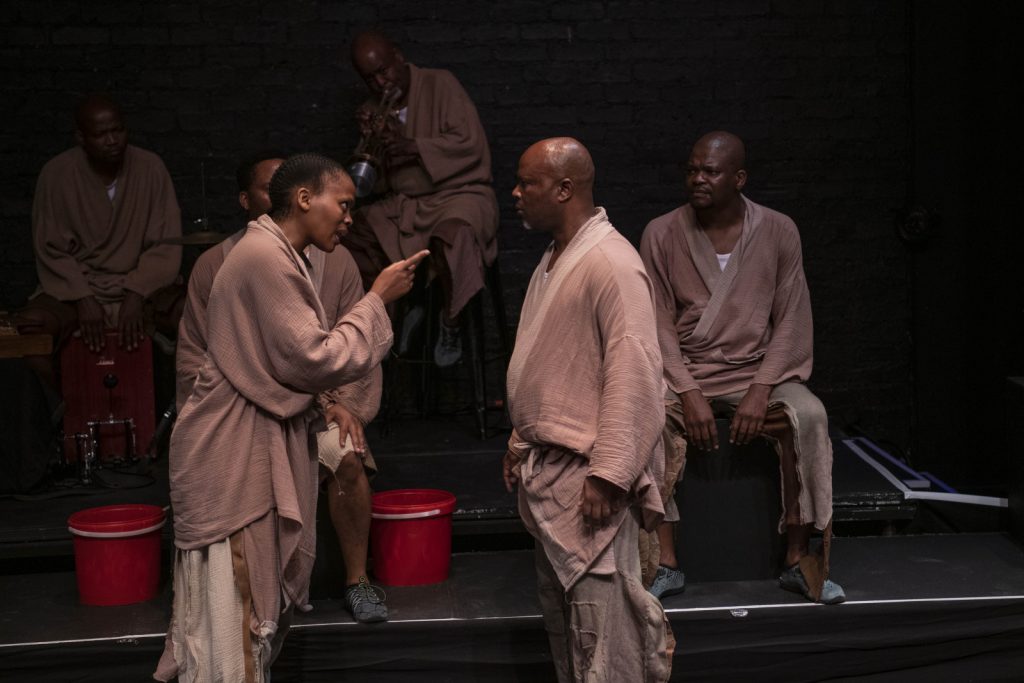The Red On the Rainbow starring Tshireletso Nkoane and Dambuza Nqumashe (Photographer Ihsaan Haffejee)
The Red on the Rainbow, a new play by award-winning playwright Monageng “Vice” Motshabi, ended its season at the Market Theatre’s Mannie Manim theatre on Workers’ Day. But this is not the end for theatre lovers and readers, because there is a book of the same title that will hopefully assume a life of its own long after the curtain call.
The play is a product of the writer’s project, Out of Sight, facilitated by the Literarisches Colloquium of Berlin in 2019.
“We were tasked to explore possibilities of political theatre and the question of invisibility in the world,” says Motshabi, the 2017 Standard Bank Young Artist for Theatre.
“It took me about six weeks to arrive at the first draft and some occasional revisiting of the text. Some sections were actually written when I met the cast, for example, the ending.”
After the performance students from film and drama schools in Johannesburg are eager to ask questions. “What techniques do the actors use?” “What was the writing process like?”
Actor Xolile Gama says the best moments of his life are when he is on stage. He has a long list of performances at the Market Theatre, including Vuka Machel, written and directed by Mncedisi Shabangu.
For actress Tshireletso Nkoane it’s all about the good direction. “I’m an actor who believes in being directed.”
For Motshabi, using African storytelling techniques in the writing process is important.
“Aesthetically it translates to how our people think of ‘story’,” he says. The Market Laboratory graduate observes people, from how the gogo next door speaks and moves to amajita (the guys) loitering at the shop corner.
These are our stories, he suggests.
The ensemble, which has toured three provinces with the work, consists of five actors who play multiple and interchangeable roles. This is what fascinates the students in the audience. “I didn’t know who was going to play certain characters. They [the actors] were not cast for the characters. I was looking for collaborators.”
This is the preferred method of the director and can be seen in his previous works such as Ankobia.

Back to The Red on the Rainbow. It is divided into encounters rather than scenes, as if to reflect the “encounters” between the coloniser and the colonised. The opening is an encounter between the five actors on an imagined farm, Makweteng. The time is now.
These fictitious events are based on an incident that happened in the small town of Coligny in North West in 2017, a couple of days before Freedom Day.
Tumelo (Thapelo Mohapi) is accused of stealing mealies at a farm owned by Piet van Vuuren (Barileng Thato Malebye) and his family. The farmers decide to play a little game with the accused after the alleged crime. Tumelo is now with the co-accused, Japie (Malebye). The game is akin to a shooting range. Only this time the targets are humans. Things spiral out of control. Tumelo is shot and the other co-accused escapes.
The audience is transported to the scene of the crime and the police station, where the crime is reported. We are witnesses.
The writer shows us the double standards of the Simunye (We are one) parody in the new South Africa. The officers called in would rather believe the farmer’s story than that of the victims. When Dorah (Nkoane), the mother of the murdered teenage boy, confronts Piet, the farmer, he in turn protests to the investigating officer: “She is disturbing the peace. My peace!”
Piet refuses Dorah entry to the farm. She wants to talk to her son, the boy Piet and his friends killed. This represents the climax of the story on Encounter 17.
In Encounter 11, we, the audience, are airlifted to the Church of Flaming Cross where an unscrupulous Pastor Moilwa (Mohapi) takes us on a spiritual journey. The accomplished musicians Sydney Mavundla and Volley Nchabeleng create an ambience of a zealous church service. But we already know that behind the congregation’s back the pastor receives bribes from the farmers. In return they demand he massages their egos.
The writer uses subtext to drive the point home. At one point the pastor turns his back to the audience to literally wipe off the lies he spits with his mouth.
Another interesting aspect is the traditional healing storyline. The healer throws the bones to diagnose society’s ailments and offers a possible remedy to ease or eradicate the pain.
The ride through the play and the book is a linguistic trapeze that swings between English and Setswana, painting the colloquialism of a small South African town. Nkoane and Mohapi are acknowledged for “the colloquial Bloemfontein speak”.
The book does provide translations.
As I leave the theatre on the chilly closing night I think about the brown robes that the actors wear on stage courtesy of Natalie Paneng. The clothes are alike for the cast and the musicians in the background. This is vintage “Vice” symbolism. In most of his works, the downtrodden rise up in victory because the real encounter comes when the masses come in.
That’s when Motshabi questions the foundations of the “new” South Africa and how the Rainbow Nation is constituted. Little has changed Motshabi. As the back sleeve of the book rebels: “The Red on the Rainbow is for our blood, which they continue to spill and splash across the land, with impunity.”
The Red on the Rainbow is published by diartskonageng and it can be purchased from the Market Theatre in Newtown or directly from Monageng Motshabi at [email protected] OR [email protected].